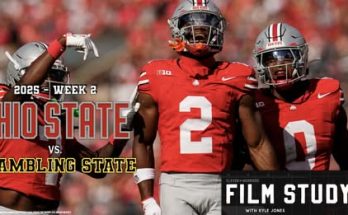The conversation around Texas football in 2025 has largely been about the quarterback play, the offensive line’s development, and the progress of the running back rotation after the program lost Bijan Robinson and Roschon Johnson a couple of years ago. Yet, when people take a closer look at why the Longhorns’ offense sometimes sputters or feels one-dimensional, there is a growing consensus that one of the biggest missed opportunities has been the underutilization of wide receiver Ryan Wingo. The freshman receiver entered Texas with one of the most decorated high school résumés in the country. A former five-star recruit from St. Louis, Wingo was seen as a game-changing addition to a wide receiver corps that already had plenty of athleticism and depth but lacked someone with the rare mix of size, speed, and versatility that Wingo brings. Coming out of high school, he was known not only for his ability to take the top off defenses but also for his polished route running, something that typically sets apart younger receivers who can contribute right away. When he committed to Texas, expectations were sky-high, and the talk around the program was that Steve Sarkisian would quickly find creative ways to deploy him within the offense. However, through the early part of the season, Wingo’s impact has been muted, with only a handful of targets and minimal opportunities to show why he was one of the most sought-after players in the 2024 recruiting class. For Texas to maximize its offensive ceiling, it’s becoming clear that Wingo must be more involved.
The Texas offense under Sarkisian is built on rhythm, spacing, and taking advantage of mismatches. Sark has always been praised as one of the best play-callers in college football, someone capable of designing schemes that get his best players in favorable matchups. With weapons like Xavier Worthy in past years, Sark showed how he could feature a receiver in ways that not only boosted individual production but also opened things up for everyone else on the field. Worthy’s ability to stretch defenses vertically forced opponents to account for him at all times, which created better running lanes and more space for underneath routes. In many ways, Wingo is the kind of player who can replicate and even expand upon that effect. He has the speed to run past defenders, the body control to win contested catches, and the agility to be used on bubble screens and jet sweeps. Texas has been at its best offensively when it has a true alpha receiver, someone who demands attention and shifts defensive game plans. Right now, that role is waiting for Wingo to claim it, but the coaching staff must make the deliberate decision to give him more opportunities.
One of the challenges for Texas has been finding balance between leaning on its veteran players and integrating younger stars. It’s natural for coaches to trust those who have been in the system longer, who know the nuances of the playbook and have developed chemistry with the quarterback. Yet, at times, that trust can come at the cost of untapped potential. Wingo may not have the same amount of in-game experience as upperclassmen, but his talent level is undeniable, and in college football, talent often trumps experience when it comes to creating explosive plays. Explosiveness is exactly what Texas has been missing in stretches of games this season. Too often, the Longhorns move the ball efficiently between the 20s but struggle to generate big gains or red-zone touchdowns when defenses tighten up. That’s where a player like Wingo can change everything. His ability to win one-on-one matchups in the red zone, combined with his knack for getting separation on deep routes, could provide the spark Texas needs to finish drives more consistently.
Another factor that makes Wingo’s involvement essential is the evolution of the quarterback position at Texas. Whether it’s Arch Manning, Quinn Ewers, or another option taking snaps, the Longhorns’ quarterbacks have shown that they’re most comfortable when they can trust a go-to receiver. Young quarterbacks, in particular, benefit from having a safety valve who can turn a risky throw into a big play. Manning has already flashed poise and arm talent, but he also occasionally plays conservatively, checking down instead of taking shots. Having Wingo on the field more frequently and schemed into plays can encourage the quarterback to trust his arm and take advantage of mismatches. The presence of an explosive weapon not only boosts confidence but also opens up Sarkisian’s full playbook. When defenses know there’s a receiver who can beat them deep at any time, they have to respect it by keeping safeties back, which in turn helps the running game. Thus, Wingo’s increased involvement would not just impact the passing attack but the entire offense.
Recruiting is another reason Texas cannot afford to let Wingo remain on the sidelines or underutilized. Players of his caliber choose programs like Texas because they are promised opportunities to shine on the big stage. Sarkisian and his staff worked tirelessly to land him, battling powerhouse programs across the country. To maintain credibility with future recruits, Texas must show that it delivers on those promises. The college football world is watching, and so are elite high school athletes considering where to commit. If a player of Wingo’s caliber goes through an entire season without being heavily featured, it could send the wrong message. By contrast, showcasing his talent demonstrates that Texas is a program where young stars can thrive immediately. That reputation helps the Longhorns not just in recruiting wide receivers but in every position group, as players across the country look for programs that empower their athletes.
From a schematic standpoint, there are countless ways to get Wingo involved without completely overhauling the offense. Sarkisian has long been a master at creating easy touches for his playmakers, whether that’s through screens, quick slants, or motion plays that get a receiver in space. Early touches can build confidence, both for Wingo and for the quarterback throwing his way. Once a rhythm is established, Texas can use Wingo to stretch the field vertically, forcing defenses into difficult choices. Do they commit extra resources to covering him, or do they risk leaving him in single coverage? Either option plays into Texas’s hands, because if Wingo draws double teams, it leaves other talented receivers with more favorable matchups. If defenses gamble with single coverage, Wingo has the skill set to make them pay. The beauty of football is that one player’s presence can completely reshape the way opponents game plan, and Wingo is precisely that kind of player.
The mental aspect cannot be ignored either. Young receivers thrive when they feel trusted and valued by the coaching staff. Consistent targets send a message: you are a priority in this offense. That kind of confidence boost can elevate a player’s performance dramatically. Conversely, limited involvement can lead to frustration, which sometimes results in transfers in the modern era of college football. Texas, with its lofty ambitions and national spotlight, needs to ensure that a talent like Wingo feels invested in the program for the long haul. A breakout game or a series of impactful performances could be the difference between him becoming the next great Longhorn receiver or him becoming a cautionary tale about underused recruits.
There’s also the broader context of Texas transitioning into the SEC, a move that has intensified the spotlight on every facet of the program. Competing with the likes of Alabama, Georgia, and LSU requires not just strong recruiting but also maximizing the talent on the roster. SEC defenses are fast, physical, and disciplined, which means Texas will need every weapon it has to succeed. Wingo’s presence could be the X-factor in games where the margins are razor thin. A single explosive play can swing momentum in the SEC, and players like Wingo are built for those moments. It’s not just about beating mid-tier teams comfortably; it’s about having enough firepower to go toe-to-toe with the best. For Texas to establish itself as a consistent contender in its new conference, fully integrating a player of Wingo’s caliber is non-negotiable.
The conversation about Wingo also touches on the identity of Texas football moving forward. Is this a program that plays conservatively, relying on experience and safe play calls, or is it a program that unleashes its most dynamic athletes and trusts them to make plays? The answer to that question will determine how far the Longhorns can go. Sarkisian has the track record and offensive mind to craft explosive game plans, but execution depends on putting the right players in the right positions. Wingo represents upside, unpredictability, and big-play potential. Those are the exact qualities Texas needs to unlock if it wants to make the jump from a good team to an elite one.
In the end, the call to get Ryan Wingo more involved is not just about feeding a five-star recruit or appeasing fans who want to see new faces on the field. It’s about recognizing what the offense currently lacks and addressing it with the most logical solution. Texas has shown flashes of brilliance but has also struggled with consistency. Wingo’s skill set directly addresses those shortcomings. He brings speed to stretch defenses, size to win contested catches, and versatility to be moved around the formation. The longer Texas waits to feature him, the more it risks leaving potential on the table. College football seasons are short, and windows of opportunity to contend for championships are even shorter. If Texas wants to maximize its 2025 campaign and build momentum heading into the SEC, the time to unleash Ryan Wingo is now.



